
THOUSANDS JOIN PILGRIMAGE PROCESSION IN MONTENEGRO TO CELEBRATE ST. BASIL OF OSTROG
Pravoslavie.ru – 13/5/17
The annual procession to Ostrog Monastery, near the town of Niksic, Montenegro, began on Wednesday, culminating in the liturgical celebrations in honor of St. Basil of Ostrog today. Around 2,000 people began the 25-mile trek from the capital of Podgorica on Wednesday, being joined by thousands more throughout the night and on Thursday, reports Balkan Insight.
The monastery, perched high up on a Montenegrin mountain, is the most popular Orthodox pilgrimage site in the region, attracting hundreds of thousands of people ever year. Many come to pray at the holy site and at the miraculous relics of St. Basil which are kept in the monastery, seeking healing. Even non-Orthodox and non-Christians are known to visit the monastery, trusting in the saint’s prayers.
St. Basil and his monastery are the pride and joy of Serbian Orthodox Christians in Montenegro. In a statement on the site of the Serbian Church in Montenegro, Fr. Predrag Specanovic stated, “Other cities in Europe may have their pilgrimage sites but only St Basil can gather such a large number of believers from different regions.”
The monastery was founded in the seventeenth century by St. Basil of Ostrog, who died there in 1671. Two cave churches remain after a fire in the 1920s, which are the main areas of the monastery today. The upper church, dedicated to the Presentation of the Lord, sits nearly 3,000 feet up the mountainside. The lower church, of the Holy Trinity, dates to 1824.
St. Nikolai Velimirovich writes about St. Basil in his Prologue from Ochrid:
Saint Basil was born in Popovo Polje, a village in Hercegovina, of simple and God-fearing parents. From his youth he was filled with love for the Church of God and when he reached maturity he entered the monastery of the Dormition of the Most Holy Theotokos in Trebinje and there received the monastic tonsure. As a monk he quickly became renowned because of his genuine and infrequently-found ascetic life. Saint Basil took upon himself mortification upon mortification, each one heavier and more difficult than the last. Later, against his will he was elected and consecrated as bishop of Zahumlje and Skenderija. As a hierarch he first lived in the monastery of Tvrdosh and from there, as a good shepherd, he strengthened his flock in the Orthodox Faith, protecting them from the cruelty of the Turks and the cunning ways of Latins. When Basil was exceedingly pressed by his enemies and Tvrdosh destroyed by the Turks, he moved to Ostrog, where he lived an austere ascetic life, protecting his flock by his ceaseless and fervent prayer. He fell asleep peacefully in Lord in the sixteenth century, leaving behind his incorrupt Relics, incorrupt and miracle-working to the present day. The miracles at the grave of Saint Basil are without number. Christians and Muslims alike come before his Relics and find healing for their gravest illnesses and afflictions. A great people’s assembly (sabor) occurs there annually on the Feast of Pentecost.
The annual pilgrimage is not a matte for tourists, but is a true spiritual undertaking. “His personality is miraculous and effective, both while he was alive and after his passing away… All those who are here are searching for truth and goodness and to heal the soul and body,” the Serbian Orthodox Church’s leading bishop in Montenegro, Amfilohije, said during last year’s pilgrimage.

